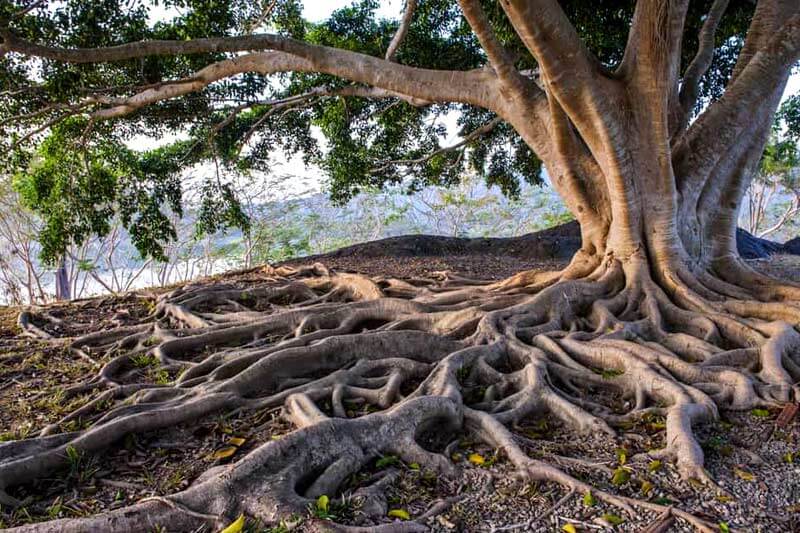The root protection zone, also known as the root protection area, is the area around a tree that cannot be excavated, surfaced, driven over, or disturbed during construction. This area will ensure that the trees retained on or off-site around the development project will not be harmed, even though it may cause construction delays.
To calculate a tree’s Root Protection Area (RPA), measure the tree’s trunk Diameter at Breast Height (DBH) and multiply by 12.
Example: Trees’ DBH = 30cm
RPA = 30cm x 12 = 3.6m
The species, age, condition of the tree, the soil type, and nature of the existing development determine the size and location of the RPA. The above is an accurate guide, but a qualified arborist can help to determine a more appropriate RPA for specific trees.
What we cover
ToggleWhat is a root protection area?
When you change the environment around the base of a tree, you can severely inhibit the tree’s ability to continue growing. One main culprit is soil compaction or sealing the immediate area beneath the tree. This inhibits the tree’s ability to soak up water and breathe.
A root protection area is the smallest area around a tree that can allow enough rooting volume to support the tree’s growth and survival.
Establishing a root protection area is critical when developing a site with trees or buildings. A root protection area may be required before obtaining a planning permit for your site.
It is necessary to have completed it if you want to maximize construction on a limited amount of land. Keep in mind that trees play an important role in planning site development and building changes worldwide.

Why is the RPA important?
Many people know that trees’ roots provide stability, but they are also responsible for the uptake of all of the tree’s water and nutrients.
As a result, the effects of root damage may not be immediately apparent but will manifest as a gradual decline in health over time. The root damage that occurred many years ago may not even be blamed for this slow decline.
Unfortunately, the RPA calculation frequently results in damaged tree roots or the construction size or area being compromised unnecessarily.
To address this, several solutions are proposed for accurately plotting the location and size of tree roots to ensure that the trees remain healthy. It provides a positive financial benefit to the project and ensures that the maximum area available to the building project is achieved.

Who would benefit from a root protection area?
The RPA is mostly used in the planning context to prevent tree loss or damage when trees are retained as part of a development. It should be read by anyone who works with trees or development.
Anyone who owns or manages trees, such as farmers, whether or not they need planning permission. A ‘layout design tool’ is what an RPA is called. It denotes the smallest area around a tree that can hold enough roots and rooting volume to keep it alive.
Need of larger root protection areas are required
We believe that RPAs for ancient and veteran trees should be higher. We propose a larger area for these trees, collaborating with the Ancient Tree Forum, than the existing standard RPA. It should be greater: a 15-times-the-tree-diameter-radius area with no cap 5m beyond the crown; or a 15-times-the-tree-diameter-radius area with no cap 5m beyond the crown.
What is the root spread range?
Tree root systems are important, but they are often overlooked because they are hidden from view.
Root systems have different patterns depending on the tree species and growing conditions, but they all work hard to absorb essential water and nutrients while also storing energy. They also provide structural support by anchoring tall, heavy trees to the ground.
Many people believe that the roots are an underground version of the crown. They are shallow and wide, primarily in the top 60cm of soil, and they extend well beyond the tree’s crown. Roots rely on the structure and health of the soil to function properly, and they require oxygen, which is scarcer deeper in the ground.
Of course, this is a task that necessitates the assistance of qualified individuals. You’ll need an arborist to calculate the root protection area for you. It will be handled by a team of arboriculturists who are qualified and experienced in this field. They provide quality services to help you ensure trees’ safety on any site you are developing.
Many property owners, managers, and developers do not clearly understand what this process entails. You may also have questions about calculating the tree root protection area and why it is necessary. These experts can explain the process in simple and understandable terms.
Roots take advantage of opportunities. When conditions are favorable, there will be more roots. More fibrous roots will grow in fertile, moist, uncompacted soils. In dry soils with no organic matter, roots are fewer but larger and can grow further away from the plant. Trees grown in the open have a larger root system than those planted close together.
Some trees, such as the Coast redwood (Sequoia sempervirens), can root-graft with other trees, sharing nutrients, stabilizing each other, and reducing stress on individual trees. With the restriction of the downward growth of the roots by a high water table or bedrock, root systems may grow wider.
On the other hand, roots can always surprise you, and a direct inspection is always necessary to determine where roots are. Finally, comparing the root system’s spread to the canopy’s spread is problematic. Pruning the drip line is simple, and the roots do not shrink to match the pruned canopy.
The diameter of the trunk is a better predictor of root spread. Susan Day and Eric Wiseman of Virginia Tech looked at young trees less than 8 inches in diameter growing in unobstructed soil in 2009. They discovered that the root radius to trunk diameter ratio was about 38 to 1. A 6-inch tree, for example, could have roots that extend 19 feet from the trunk. However, fewer studies on mature trees suggest a lower ratio for older trees.










